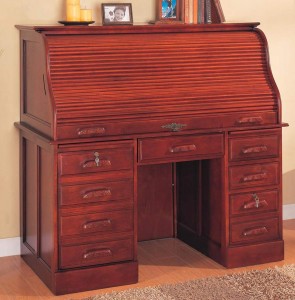
One well-known use of the term is for a type of embroidery. Fabric is tightly stretched over a frame that has two hooks on either end. The embroidery is then employed with a specialized tambour-hook or a needle. The stitching technique originated in Persia, Turkey, China and India. It didn’t catch on in Europe until the 18th century and in the U.S. during the 19th.
Being furniture-specific, however, a tambour is a type of shutter that is flexible and is able to slide back and forth when set inside of pre-existing grooves.
A type of secretary, a tambour desk is one in which the upper hutch features covered shelving or storage. The distinctive panels that cover those spaces are made up of separate wooden strips that have been glued to a firm canvas or similar materials.
Although they both feature the characteristic sliding wood panels, tambour desks and “roll-top” desks have some distinct explicit differences.
Tambour desks, as pictured here, have upright paneling that allows you to still utilize a portion of the desk space without having to open the covered storage area.
On the contrary, “Roll-top” desks traditionally have a large, single shutter that covers the entire surface of the desk.
Both of these desks are great for being able to utilize the storage space without having to necessarily straighten up the surface before leaving. Simply slide the tambours closed and what results is a presentable, well-designed piece of furniture.

